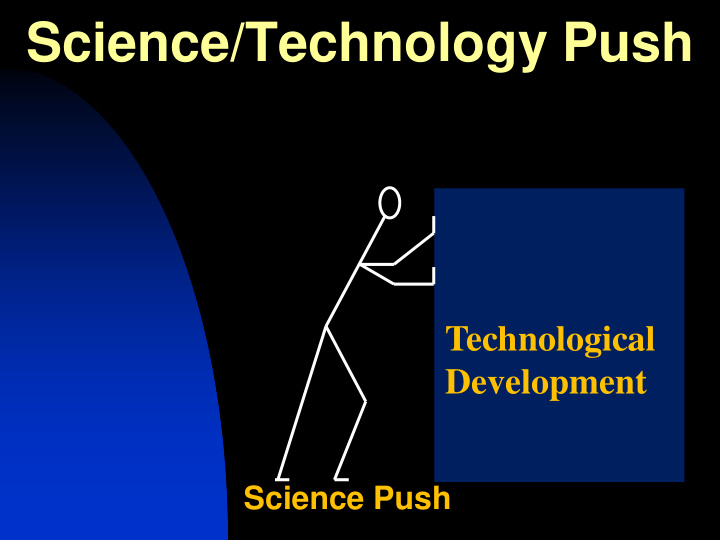



Science/Technology Push Technological Development Science Push
Market Pull Incremental Technological Improvement Market Pull
Science-Push Innovation Manufacturing Marketing Basic Design & Sales science Engineering Demand-Pull Innovation Market Need Development Manufacturing Sales
Consequences of Partial Understanding of the Innovation Process Seeing innovation as a linear 'technology push' process or one in which the market can be relied upon to pull through innovation Seeing innovation simply in terms of major 'breakthroughs' and ignoring the significant potential of incremental innovation Electric bulb first introduced in 1880 80% fall in process cost in 16 years Seeing innovation as product or process only without recognizing the interrelationship between the two
Combined Effect of Technology Push & Market Pull Market Pull Science Push
The Coupling Model New Needs of society and the market place need Manufac- Idea Prototype Marketing Market Research, generation turing production & sales place design & development New State of the art technology and production technology
Integrating Technology Push and Market Pull to Stimulate Innovation Opportunities for Opportunities for Innovation Technology Push Market Pull Scientific discoveries Market demand Applied knowledge Proliferation of Recognized needs application areas Intellectual capital Recognized needs Opportunities for (Scientists & engineers) increased: profitability, quality, productivity Entrepreneurs
What’s the Connection? Perfect Eyesight High Fidelity Music Retail Revolution
Throwing Light
Progress in Transportation 10 -1 Nuclear Fraction of velocity of Light Rockets 10 -2 10 -3 Chemical Rockets 10 -4 Jet Aircraft 10 -5 Propeller Aircraft 10 -6 Automobiles Trains 10 -7 Horse Carriage 1750 1850 1950 2050
Technology S-Curves Graphical representations of the development of a new technology Compare some measure of performance with some Technology measure of effort improves slowly at The relationship first between effort and performance is typically Then accelerates S-shaped Then tapers off
Natural Limit of Given Technology Era of capital intensity and financial domination Technical Advance Era of process improvement and manufacturing domination Era of product of innovation and engineering domination Time Technology Maturation
Technology Lifecycle/ S-curves Stage 1. Technology development Stage 2. Technology application Stage 3. Application launch Stage 4. Application growth Stage 5. Technology maturity Stage 6. Degraded technology
Radical and Incremental Technological Change Most technological innovation is incremental, and involves small improvements to existing technologies Some technological innovation is radical, and involves fundamentally new ways of solving a problem
S-Curve of Technology Evolution Declining Improvement Rapid Improvement Emergence Maturity Stage 1 Stage 2 Stage 3 Stage 4 Time Technology Evolution refers to the changes in performance characteristics of a specific technology over time
Stages of Evolution Emergence Technology has come into existence but shows little improvement in its performance characteristics Rapid Improvement Performance characteristic improves at an accelerating pace Declining improvement Pace of improvement declines Maturity Further improvements become very difficult to achieve
Business and Innovation
Why Is Progress Slow ? Long gestation period Want of relevant design or production know-how Execution into new products requires special tools, processes and fixtures Learning Curve Technology Limits
Technological Improvements Along an S-curve Tend to be incremental, building on prior developments, and taking place within an existing paradigm Usually done by established firms: they have existing technical, market, and organizational capabilities they have an existing customer base they have access to internal cash flow to invest
Shifting S-Curve Example Traditional Switching VOIP
Who Shifts the S-Curve? Usually new entrants because: Incumbents have no incentive to introduce the new technology Incumbents have investments in existing technology Products based on the new technology cannibalize incumbents’ sales Managers at incumbent firms do not see the new technology as a threat Incumbent firms can improve the performance of their old technologies Incumbent firms face organizational obstacles to changing their core technologies
Why incumbent Firms Fail in the Face of Architectural Innovation Often lack the right external linkages to gather information about a new technology architecture emerging in an industry Often lack the capacity to recognize the value of information about architectural innovation that is presented to them Often have difficulty making use of information because adopting an architectural innovation typically requires a company to restructure
Assignment # 3 Opportunity Now!
Key Sectors for “Opportunity Now” Exercise Food Energy Clothing Communication Housing Healthcare Transportation Entertainment
The Innovation Opportunity Grid Product Process Strategy Break- through Substan- tial Incre- mental
Recommend
More recommend